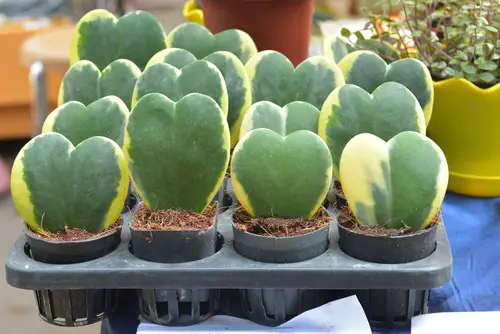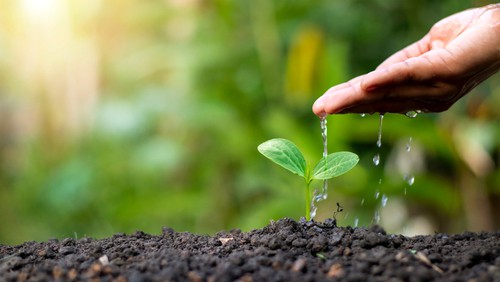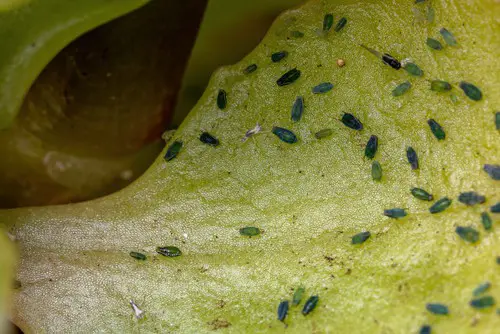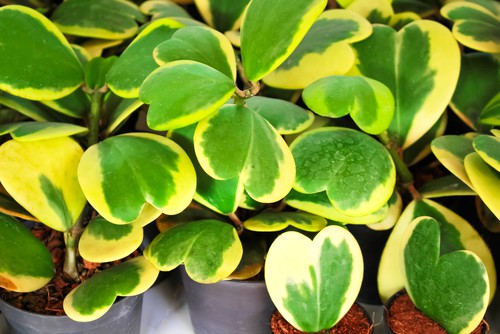Hoya plants are a popular choice among indoor gardeners due to their beautiful foliage and low maintenance requirements. However, it can be alarming to see hoya plant leaves turning yellow.
Yellowing leaves can be a sign of various issues, including improper lighting, watering, and nutrient deficiencies. It is essential to identify the root cause of the problem to prevent further damage to the plant.
Understanding Hoya plants is crucial to maintaining their health. These plants are native to tropical regions and require bright, indirect light, high humidity, and well-draining soil.
They are sensitive to temperature changes and can suffer from stress due to environmental factors. When hoya leaves turn yellow, it can be an indication of a problem with the plant’s growing conditions. Identifying the cause of yellowing leaves is the first step in reviving your hoya plant’s health.
Lighting and temperature factors, watering and moisture issues, nutrient deficiencies and fertilizer problems, pests and diseases, root rot and overwatering, and stress and environmental factors are all potential causes of hoya leaves turning yellow.
By understanding these factors and how they affect your plant, you can take steps to prevent and correct yellowing leaves. With proper care and attention, your hoya plant can thrive and continue to add beauty to your indoor space.
Key Takeaways
- Yellowing leaves on a hoya plant can indicate various issues, including lighting, watering, and nutrient deficiencies.
- Hoya plants require bright, indirect light, high humidity, and well-draining soil to thrive.
- Identifying the root cause of yellowing leaves is crucial to preventing further damage to the plant.
Related posts:
Understanding Hoya Plants

Hoya plants, also known as wax plants, are popular houseplants that are native to Southeast Asia and Australia. These epiphytes are known for their beautiful, waxy leaves and fragrant, star-shaped flowers. Hoya plants are relatively easy to care for and can thrive in a variety of indoor environments.
Hoya plants are members of the Apocynaceae family, which also includes plants such as periwinkles and oleanders. There are over 200 species of hoya plants, each with its own unique characteristics. Some species of hoya plants are known for their variegated leaves, while others are prized for their fragrant flowers.
Hoya plants are epiphytes, which means that they grow on other plants rather than in soil. In their natural habitat, hoya plants can be found growing on trees and other structures. Hoya plants have adapted to this environment by developing specialized roots that can absorb nutrients and moisture from the air.
When grown as houseplants, hoya plants should be planted in well-draining soil and placed in a bright, indirect light. Hoya plants prefer warm temperatures and high humidity, so they should be kept away from drafts and dry air.
Hoya plants should be watered regularly, but care should be taken not to overwater them. Overwatering can lead to root rot and other problems. Hoya plants should also be fertilized regularly with a balanced fertilizer to promote healthy growth.
Identifying Yellow Leaves
When it comes to Hoya plants, yellow leaves can be a sign of a problem. Identifying yellow leaves is the first step in figuring out what is causing the issue. Here are a few things to look for:
1. Location of Yellow Leaves
Take note of where the yellow leaves are located on the plant. Are they at the top or bottom of the plant? Are they on the newer or older leaves? This information can help determine the cause of the yellowing.
2. Type of Yellowing

Yellowing can manifest in different ways. The entire leaf may turn yellow, or just parts of it. The yellowing may be uniform or splotchy. The edges of the leaves may turn yellow first. These variations can indicate different underlying causes.
3. Other Symptoms
Yellowing leaves may be accompanied by other symptoms, such as wilting, spotting, or curling. These symptoms can provide additional clues as to the cause of the yellowing.
4. Possible Causes
There are several possible causes of yellowing leaves in Hoya plants, including:
- Overwatering or underwatering
- Poor drainage
- Lack of nutrients
- Exposure to cold temperatures
- Exposure to direct sunlight
- Pests or diseases
Identifying the cause of the yellowing leaves is important in order to address the issue and prevent further damage to the plant.
Lighting and Temperature Factors
The lighting and temperature conditions are crucial factors that affect the health of the Hoya plant. The plant requires bright, indirect light to thrive, and too much direct sunlight can cause the leaves to turn yellow and even burn. On the other hand, insufficient light can lead to stunted growth and yellowing of the leaves.
It is recommended to place the Hoya plant near a north or east-facing window where it can receive bright, indirect light throughout the day. If the plant is placed near a south or west-facing window, it is advisable to use sheer curtains or blinds to filter the intense sunlight.
Temperature is another important factor that affects the Hoya plant’s health. The plant prefers warm temperatures ranging between 60°F to 80°F (15°C to 27°C). However, high temperatures can cause the leaves to turn yellow and even drop off.
Temperature stress can also occur if the plant is exposed to sudden changes in temperature, such as cold drafts or hot air blowing from heating vents. It is best to keep the Hoya plant away from air conditioning units and heating vents to avoid temperature stress.
Watering and Moisture Issues

One of the most common reasons for yellowing leaves in Hoya plants is watering issues. Overwatering or underwatering can cause stress to the plant, leading to yellowing leaves. It’s essential to keep the soil moist but not waterlogged.
When watering your Hoya plant, it’s crucial to ensure that the water drains out of the pot. The plant’s roots should not sit in water for extended periods as this can lead to root rot. To prevent this, ensure that the pot has drainage holes at the bottom.
It’s also important to pay attention to the quality of the water you use to water your Hoya plant. Tap water may contain chlorine, fluoride, and other chemicals that can harm the plant. Rainwater or distilled water is a better option.
The frequency of watering will depend on the plant’s environment, the size of the pot, and the type of soil. As a general rule, water your Hoya plant when the top inch of soil feels dry to the touch. In hot weather, you may need to water more frequently.
Underwatering can also cause yellowing leaves in Hoya plants. If the soil is too dry, the plant may not be getting enough water. It’s important to ensure that the soil is moist but not waterlogged. If you notice that the soil is dry, water the plant thoroughly.
Nutrient Deficiencies and Fertilizer Problems
Hoya plants require a balanced supply of nutrients to maintain healthy growth and vibrant foliage. Nutrient deficiencies and fertilizer problems are common reasons for Hoya leaves turning yellow.
Nitrogen, potassium, magnesium, and phosphorous are essential nutrients that Hoya plants require in sufficient quantities. Nitrogen is crucial for the production of chlorophyll, which gives leaves their green color.
A lack of nitrogen can cause yellowing of leaves, stunted growth, and reduced flowering. Potassium is necessary for root development and water regulation. Magnesium is a component of chlorophyll, and its deficiency can cause yellowing of leaves. Phosphorous is essential for energy transfer and root development.
A nutrient deficiency can cause Hoya leaves to turn yellow because all living things require nutrients to survive and thrive. When a Hoya plant lacks essential nutrients, it affects the production of chlorophyll, which accounts for green-hued foliage.
On the other hand, over-fertilization can also cause yellowing of the leaves. Applying too much fertilizer can lead to nutrient burn, which can cause the leaves to turn yellow, brown, or black. It is essential to follow the instructions on the fertilizer package and not exceed the recommended dosage.
To prevent nutrient deficiencies and fertilizer problems, it is crucial to use a balanced fertilizer that contains all the essential nutrients in the right proportions. A balanced fertilizer should have an equal proportion of nitrogen, potassium, and phosphorous, with additional micronutrients like magnesium, iron, and calcium.
Regular soil testing can help identify nutrient deficiencies and imbalances, and the appropriate fertilizer can be applied to correct the problem. It is also essential to water the plant thoroughly before applying fertilizer to prevent root burn.
Pests and Diseases

Hoya plants are generally easy to care for, but they are still susceptible to pests and diseases. Here are some of the most common issues to watch out for:
Pests
Mealybugs, aphids, and spider mites are the most common pests that can infest Hoya plants. These pests suck the sap from the leaves and stems, causing the leaves to turn yellow and eventually fall off. If left untreated, a pest infestation can quickly spread to other plants in the area.
To get rid of pests, use a mild insecticidal soap or neem oil spray. Be sure to coat both the tops and bottoms of the leaves, as this is where the pests tend to congregate. Repeat the treatment every week or two until the pests are gone.
Diseases
Hoya plants can also be affected by various diseases, including root rot, leaf spot, and powdery mildew. These diseases can cause the leaves to turn yellow and wilt.
To prevent diseases, make sure your Hoya plant is not overwatered and is planted in well-draining soil. If you notice any signs of disease, remove the affected leaves or stems and treat the plant with a fungicide. Be sure to follow the instructions carefully and repeat the treatment as necessary.
Overall, keeping a close eye on your Hoya plant and taking preventative measures can help keep it healthy and free from pests and diseases.
Root Rot and Overwatering
One of the most common reasons for hoya plant leaves turning yellow is root rot caused by overwatering. Hoya plants are sensitive to overwatering and require well-draining soil to thrive.
When the roots of the plant are constantly wet, they become waterlogged and start to rot. This rotting of the roots can cause the leaves of the plant to turn yellow.
To prevent root rot, it is important to ensure that the soil is well-draining. This can be achieved by adding perlite or cactus mix to the potting soil. These materials help to improve drainage and prevent water from accumulating in the soil.
Another way to prevent root rot is to use a potting medium that is well-suited for hoya plants. Sphagnum moss is an excellent potting medium for hoya plants as it is able to retain moisture without becoming waterlogged. It also provides good drainage and aeration for the roots of the plant.
When watering hoya plants, it is important to avoid overwatering. The soil should be allowed to dry out slightly between watering. This will help to prevent the roots from becoming waterlogged and rotting.
Stress and Environmental Factors

Hoya plants are generally low-maintenance and easy to care for, but they can experience stress and environmental factors that cause their leaves to turn yellow. Understanding the causes of stress and environmental factors can help you address the problem and keep your Hoya plant healthy.
1. Temperature Stress and Acclimation
Hoya plants are native to tropical and subtropical regions of Southeast Asia and Northern Australia, so they prefer warm and humid conditions. Sudden changes in temperature or exposure to extreme temperatures can cause stress and yellowing of the leaves.
When moving a Hoya plant from one location to another, it is important to give it time to acclimate to the new environment.
2. Air and Oxygen
Hoya plants require good air circulation and oxygen to thrive. Poor air quality or stagnant air can cause stress and yellowing of the leaves. Make sure your Hoya plant is located in a well-ventilated area with good air circulation.
3. Drought and Overwatering
Drought and overwatering can both cause stress and yellowing of the leaves. Hoya plants prefer to be watered when the top inch of soil is dry, but they should not be allowed to completely dry out. Overwatering can lead to root rot, which can be fatal to the plant.
4. Aging
As Hoya plants age, their leaves may naturally turn yellow and fall off. This is a normal part of the plant’s life cycle, and is not necessarily a cause for concern. However, if the yellowing is accompanied by other symptoms, such as wilting or leaf drop, it may be a sign of stress or environmental factors.
Prevention and Care

Preventing Hoya leaves from turning yellow requires proper care and attention. Here are some tips to help keep your Hoya plant healthy:
- Watering: Overwatering is the most common cause of yellow leaves on Hoya plants. Make sure to water the plant only when the soil is dry to the touch. Avoid letting the plant sit in water, as this can lead to root rot. On the other hand, underwatering can also cause yellowing leaves. Make sure to water the plant thoroughly when the soil is dry.
- Repotting: Hoya plants should be repotted every two to three years. Use a well-draining soil mix and a pot with drainage holes to prevent water from accumulating in the soil.
- Blooming: Hoya plants need bright, indirect light to bloom. Make sure to place the plant near a window that receives plenty of light. You can also use artificial grow lights to provide the plant with the necessary light.
- Photosynthesis: Hoya plants rely on photosynthesis to produce energy. Make sure to keep the plant near a window that receives plenty of light. You can also use artificial grow lights to provide the plant with the necessary light.
- Chlorophyll and Chloroplasts: Chlorophyll and chloroplasts are essential for photosynthesis. Make sure to provide the plant with the necessary nutrients, including nitrogen, phosphorus, and potassium.
- Chlorosis: Chlorosis is a condition that causes yellowing leaves due to a lack of chlorophyll. Make sure to provide the plant with the necessary nutrients, including nitrogen, phosphorus, and potassium.
- Common Problems: Hoya plants are susceptible to pests and diseases, including mealybugs, spider mites, and root rot. Make sure to inspect the plant regularly for signs of pests or disease.
- Hoya Carnosa: Hoya Carnosa is a popular species of Hoya plant. It requires bright, indirect light and well-draining soil to thrive.
- Cactus: Hoya plants are not cacti and require different care. Avoid using cactus soil mix for Hoya plants, as it may retain too much moisture.
- Chlorine: Chlorine in tap water can harm Hoya plants. Make sure to use distilled or filtered water when watering the plant.
Frequently Asked Questions

How do I prevent my Hoya plant leaves from turning yellow?
To prevent Hoya plant leaves from turning yellow, it is important to ensure that the plant is getting the right amount of water, light, and nutrients.
Overwatering can cause yellow leaves, so make sure to water the plant only when the soil is dry to the touch. Hoya plants also require bright, indirect light, so make sure to place them in a location with adequate lighting.
Additionally, fertilize the plant every two to three months during the growing season with a balanced fertilizer.
What causes yellow leaves on a Hoya plant?
Yellow leaves on a Hoya plant can be caused by a variety of factors, including overwatering, underwatering, insufficient lighting, nutrient deficiencies, and pests. It is important to identify the specific cause of yellow leaves in order to properly address the issue.
What are the signs of overwatering a Hoya plant?
Signs of overwatering in a Hoya plant include yellowing leaves, wilting, and root rot. Overwatering can lead to waterlogged soil, which can cause the roots to suffocate and die.
How often should I water my Hoya plant?
Hoya plants should be watered only when the soil is dry to the touch. Depending on the humidity and temperature of your environment, this may be once a week or every two weeks. It is important not to overwater the plant, as this can lead to root rot and yellow leaves.
Why are the leaves on my Hoya plant turning light green?
Light green leaves on a Hoya plant can be a sign of insufficient lighting. Hoya plants require bright, indirect light to thrive. If the plant is not getting enough light, it may produce light green leaves in an attempt to maximize photosynthesis.
What can I do to fix yellow spots on Hoya plant leaves?
Yellow spots on Hoya plant leaves can be caused by a variety of factors, including nutrient deficiencies, pests, and diseases. To fix yellow spots, first identify the specific cause of the issue.
If the cause is a nutrient deficiency, fertilize the plant with an appropriate fertilizer. If the cause is pests or disease, treat the plant with an appropriate pesticide or fungicide.

Hey, I’m Lisa and I’ve been an avid gardener for over 30 years. I love writing, talking and living in the garden! Feel free to connect with me on my socials below


